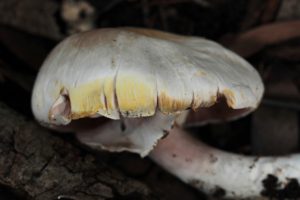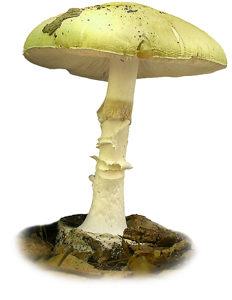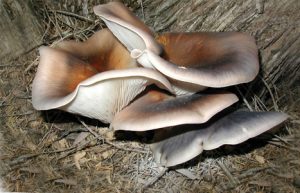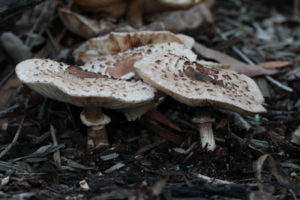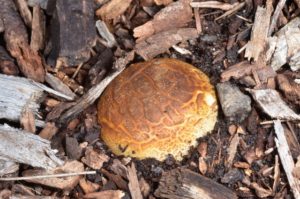In brief:
Emergency: If you suspect that you or someone you know has been poisoned by eating fungi, call the Poisons Information Centre on 13 11 26
The most common cause of poisonings due to ingestion in Australia is Agaricus xanthodermus – Yellow-staining mushroom. Less common but more dangerous is the Death Cap, Amanita phalloides, which has led to several fatalities in Melbourne and Canberra.
Other fungi known to cause poisonings in Australia include Omphalotus nidiformis – Ghost Fungus, Chlorophyllum brunneum – Shaggy Parasol, and species of Scleroderma – Earthball that have been mistakenly collected as truffles.
Edible fungi – R.V. Southcott, one of Australia’s greatest doctor-naturalists, puts the matter starkly:
The edibility of most Australian species of fungi is untested (1996).
Fungimap does not encourage eating wild Australian mushrooms because so little is known about their edibility and many poisonous species are virtually indistinguishable from safe varieties.
Poisonous fungi – there are three kinds of poisonous fungi:
- Ones that will kill you
- Ones that will make you seriously ill
- Ones that will give you hallucinations
The most deadly is the Amanita phalloides – Death Cap, responsible for 90% of the deaths attributable to fungal poisoning in the world (Southcott, 1996; p. 298). Death is painful and unpleasant. There are no symptoms for the first 12 hours or so, then the victim experiences violent stomach pain and gastroenteritis, followed by vomiting and diarrhoea. Then the effects pass, but only for a couple of days. By that time the toxin has smashed its way through the victim’s liver and kidneys, giving A. phalloides an unenviable 50% death rate (Southcott, 1996; p. 300). Should you survive, you are likely to have major kidney and liver damage. If you learn to identify only one fungus in your life, this is the one.
Here’s how to recognise the deadly Death Cap:
- a yellowish to greenish cap, sometimes brownish (typically olive-green in the centre and becoming yellowish-green towards the margin)
- white, free gills
- white spores
- a white central stem usually with a ring
- at its base there is a large, membranous, cup-like volva
- it usually grows on its own or in sparse groups below oak trees (Quercus spp.), but on rare occasions has also been spotted in large groups. It has also been found in association with Fagus (beech) tree species in Australia, and associates with Quercus, Fagus, Betula, Castanea, and Picea in its native Europe.
Warning: if you pull up a specimen to examine it, do so carefully, preferably using gloves, and wash your hands thoroughly afterwards.
It is found in southern Australian states from southern WA to NSW, but its territory may be expanding.
To take a spore print: Place the the cap (or a piece of cap) gills down on overlapping black and white pieces of paper and leave it for two to three hours. The gills will drop enough spores to give you a coloured print, and if it shows up white against the black paper that is a good indication – taken together with the other characteristics – that it is a Death Cap.
Look-alikes: The similar-looking Leucoagaricus leucothites – Smooth White Parasol has no green colour in the cap and no volva. Volvopluteus gioicephalus – Common Rosegill has no green colour in the cap, no ring and a pink-brown spore print. Further excellent information by the Australian Botanic Gardens on identifying the Death Cap is here.
Read here the Fungimap blog post on recognising Amanita phalloides.
Other Australian mushrooms have very similar toxins to Amanita phalloides, including Galerina, Gyromitra, Lepiota and Cortinarius.
A much larger group will make you very ill. Tony Young makes the point that this may be due to poisons in the fungus, an allergy, or sensitisation (Young, 1994). Some species, notably Paxillus involutus, can cause acute sensitisation, resulting in death in some cases.
Amanita muscaria – Fly Agaric, easily identified by almost everyone from its constant presence in pictures from fairy stories, will cause gastrointestinal upsets, as will many other fungi. It is easy to recognise so poisoning from this species is almost unheard of. Apparently everyone knows it’s poisonous!
Agaricus xanthodermus – Yellow-staining mushroom, the most common cause of poisoning from wild fungi (see top two photos at top of this page). It is similar in appearance to the field mushroom (Agaricus campestris) and the cultivated mushroom (Agaricus bisporus), but differs in the rather square profile of the cap when young, the strong unpleasant odour (like hospital disinfectant – caused by the presence of phenol in the mushroom) and the yellow stain when the cap or stem is bruised. Old specimens may have brown caps, with the stain not clear, but usually the flesh in the stem base always bruises yellow (best seen by cutting the stem in half and rubbing the cut surface of the stem base).
The hallucinatory or psychotropic mushrooms are another group. The most popular of these seems to be Psilocybe subaeruginosa, often known as ‘Golden Tops’. While there are obvious dangers to those who drive under the influence of psychotropic mushrooms, some species of Galerina bear a striking similarity to Psilocybe and occur in similar habitats, increasing the possibility of a fatal psychotropic feast. As above, some Galerinas have the same kind of toxins as the deadly Amanitas. Moreover, for many species of hallucinatory mushrooms there is a fine line between ingesting an amount that will produce hallucinations and ingesting an amount that could cause serious organ damage or even death.
There is no sure way to tell if a fungus is poisonous. However, there are many popular (and dangerous) myths about poisonous fungi.
Here are the facts:
- not all dangerous fungi taste unpleasant
- almost none of them will stain a silver spoon black
- only one or two change colour when the flesh is bruised
- an animal (including your dog) is just as likely to try a poisonous mushroom as a non-poisonous one
- the only certain way to know if it is poisonous is to identify it
But so little of Australia’s fungi have been collected and identified that the chances are good that you could easily be the discoverer of an even more deadly mushroom than the Death Cap. Many Australian species look superficially like popular edible European species. This has resulted in more than a few hospital admissions.
A safer way to enjoy mushrooms is to learn how to grow your own. Fungimap does not offer any specific advice about doing this, but Forest Fungi and Milkwood have courses for growing mushrooms at home.
Ecological Foraging
For those who do forage for wild mushrooms, we highly recommend Wild Mushrooming by Alison Pouliot and Tom May, available from the Fungimap bookshop. The book gives comprehensive information on known poisonous and toxic species in Australia, as well as how to safely identify a few common edible species.
The book encourages foragers to take a specifically Australian approach that minimises ecological and personal harm. Foragers need to appreciate the ecological significance of fungi and potential environmental impacts of their harvesting. The authors recommend practices that minimise disturbance to fungi and their environments:
Code of practice for foragers (from page 56 of Wild Mushrooming):
- Seek permission from the property owner if not on your own land
- Cause minimal disturbance to the environment. Do not disturb soil, leaf litter, remove wood or turn over logs and not replace them.
- Check that the area you are collecting from is not contaminated (eg verges on busy roads, old landfill tip sites, highly managed parks, gardens or golf courses).
- Only collect target species and take only as many as you will consume that day. Leave plenty for wildlife.
- Allow sporophores time to release their spores by not collecting immature sporophores (buttons). Buttons can be difficult to identify as they often have not yet developed important diagnostic features and can be easily confused with toxic fungi.
- Carry a field guide such as Wild Mushrooming and identify fungi in situ.
- Respect and protect all fungus species including poisonous ones.
- Fungi are appreciated by different people for different reasons, often simply for their beauty. Consider their interests too and be sure to minimise the visual effects of your harvesting (eg do not leave sporophores overturned. Dispose of any ‘trimmings’ or offcuts discretely in the immediate area).
- Take all your rubbish home (such as latex gloves worn by some foragers).
- Be aware of local laws and by-laws.
References:
Kalotas, A.C.(1996) Aboriginal knowledge and use of fungi. in: Fungi of Australia. Vol IB. CSIRO:Melbourne, pp. 269-295
Pouliot, A. and May, T. (2021) Wild Mushrooming: A Guide for Foragers. CSIRO Publishing: Melbourne.
Southcott, R.V (1996) Mechanisms of macrofungal poisoning in humans. in: Fungi of Australia. Vol IB. CSIRO:Melbourne pp. 295-313
Spencer, B. and Gillen, F.J. (1904) The Northern Tribes of Central Australia. Macmillan: London
Young, Tony (1994) Common Australian Fungi: A naturalist’s guide. NSW University Press: Kensington

